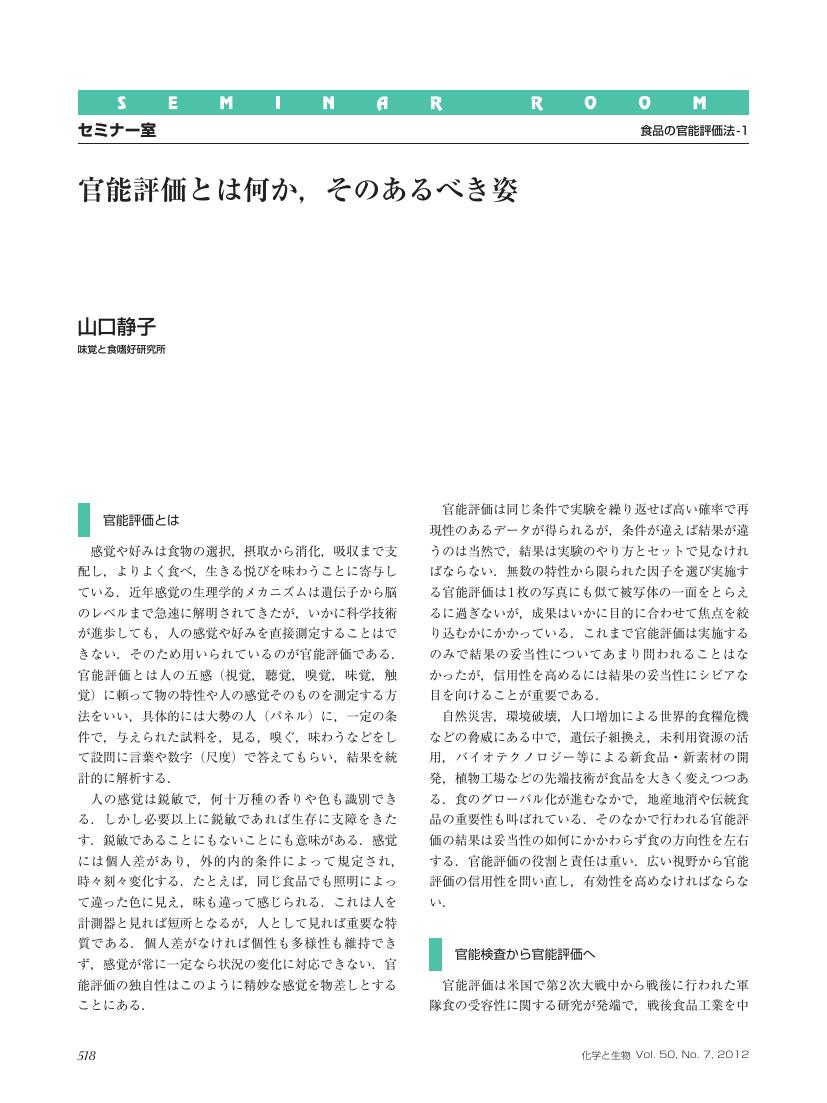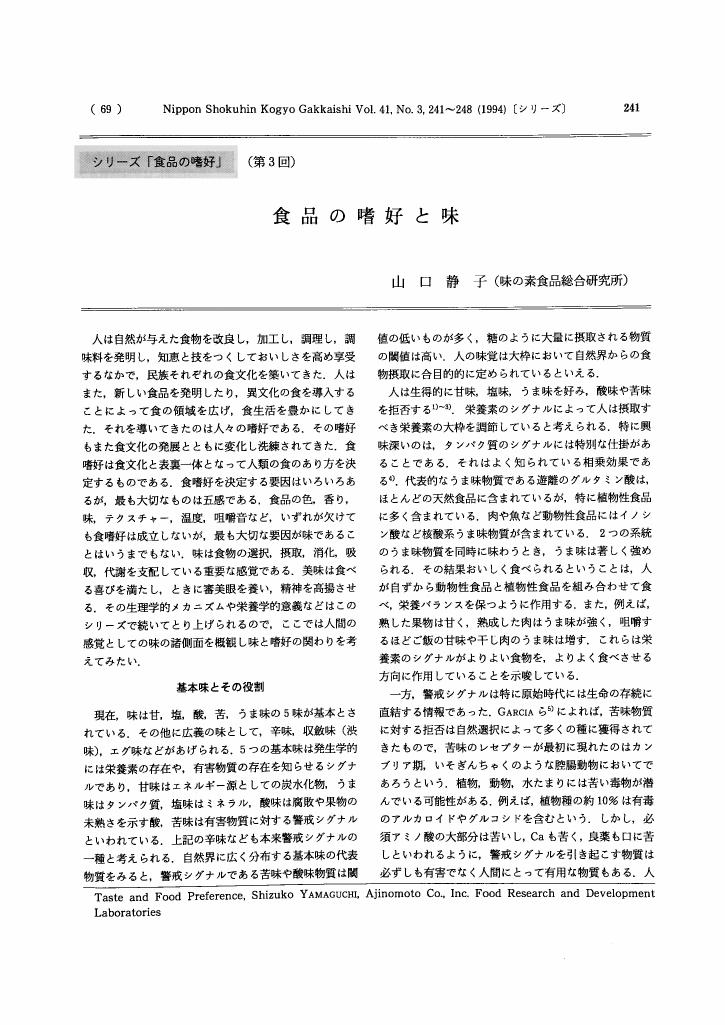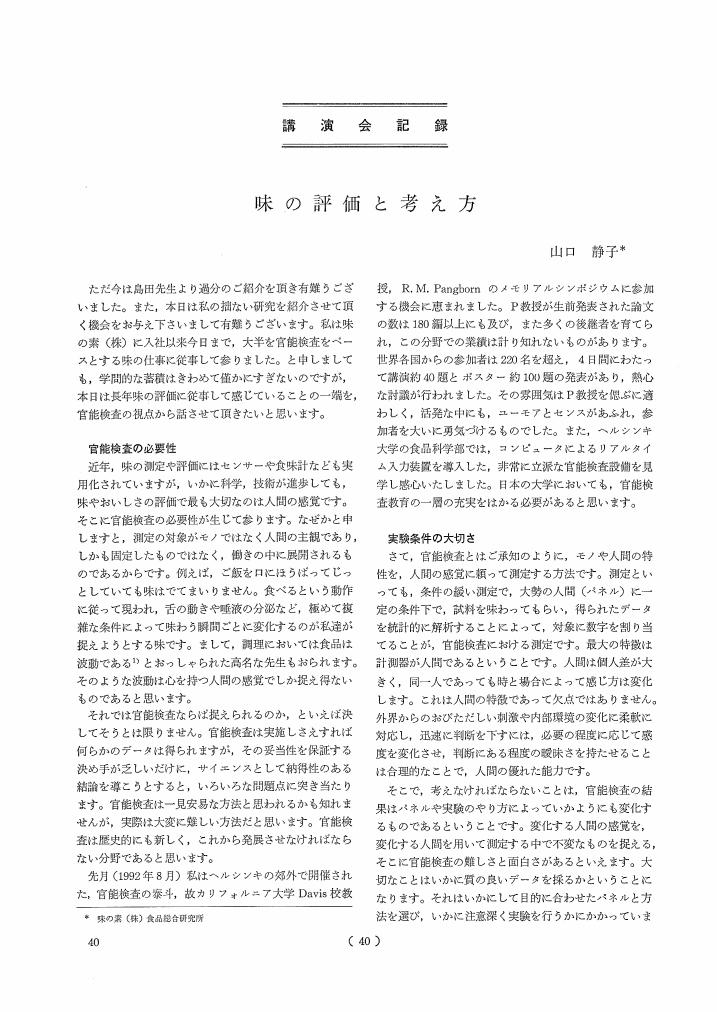27 0 0 0 OA 官能評価とは何か,そのあるべき姿
- 著者
- 山口 静子
- 出版者
- 公益社団法人 日本農芸化学会
- 雑誌
- 化学と生物 (ISSN:0453073X)
- 巻号頁・発行日
- vol.50, no.7, pp.518-524, 2012-07-01 (Released:2013-07-01)
- 参考文献数
- 10
- 被引用文献数
- 2
4 0 0 0 OA 食品の嗜好と味
- 著者
- 山口 静子
- 出版者
- Japanese Society for Food Science and Technology
- 雑誌
- 日本食品工業学会誌 (ISSN:00290394)
- 巻号頁・発行日
- vol.41, no.3, pp.241-248, 1994-03-15 (Released:2009-04-21)
- 参考文献数
- 47
- 被引用文献数
- 1 1
2 0 0 0 OA 味の研究における官能検査の役割と有効性
- 著者
- 山口 静子
- 出版者
- Japanese Society for Food Science and Technology
- 雑誌
- 日本食品工業学会誌 (ISSN:00290394)
- 巻号頁・発行日
- vol.38, no.10, pp.972-978, 1991-10-15 (Released:2009-04-21)
- 参考文献数
- 43
- 被引用文献数
- 8 15
- 著者
- 山口 静子
- 出版者
- 東京大学
- 雑誌
- 東京大学史料編纂所報 (ISSN:03869008)
- 巻号頁・発行日
- vol.18, pp.44-60, 1983
1 0 0 0 OA 知覚プロセスを考慮したトマトのおいしさの総合的評価
- 著者
- 玉木 有子 阿久澤 さゆり 澤山 茂 飯田 文子 山口 静子
- 出版者
- 日本官能評価学会
- 雑誌
- 日本官能評価学会誌 (ISSN:1342906X)
- 巻号頁・発行日
- vol.7, no.1, pp.25-36, 2003-04-15 (Released:2013-10-05)
- 参考文献数
- 17
- 被引用文献数
- 2 2
Consumers‘ quality perception and preference of tomatoes were measured during the whole process of eating. Words expressing the features of palatable and unpalatable tomatoes were collected and 91 pairs of words were selected to formulate the evaluation sheet for sensory evaluation. Fifteen kinds of tomatoes were chosen for test samples, at Tokyo Ohta Fruit and Vegetable Market, from those produced in various areas under the name of Momotarow, the most popular original kind in Japan. Panel was consisted of 307 university students. Each panelist was given a whole fresh tomato and evaluated the 91 items according to the process of eating, i.e., looking, holding, peeling, biting, tasting, and swallowing, using seven-point scales. Principal component analysis was applied both for mean average scores of 15 samples and individual scores of total 307 samples. Results in both cases showed that the total variance was mainly explained by two components. PC1 was related to taste (sweet, sour and umami), texture and flavor in the mouth. PC2 was related to ripeness. Multiple regression analysis showed that the total evaluation of tomatoes was mostly explained by the properties perceived in the mouth and only a small amount by those perceived through visual and tactile senses.
1 0 0 0 OA 味の評価と考え方
- 著者
- 山口 静子
- 出版者
- 一般社団法人 日本調理科学会
- 雑誌
- 調理科学 (ISSN:09105360)
- 巻号頁・発行日
- vol.26, no.1, pp.40-46, 1993-02-20 (Released:2013-04-26)
- 参考文献数
- 13
1 0 0 0 OA 富山産かぶらずしの理化学特性と食味
- 著者
- 上野 真理子 寺島 晃也 多田 耕太郎 山口 静子
- 出版者
- 社団法人 日本食品科学工学会
- 雑誌
- 日本食品科学工学会誌 (ISSN:1341027X)
- 巻号頁・発行日
- vol.54, no.3, pp.118-127, 2007-03-15 (Released:2007-10-04)
- 参考文献数
- 27
- 被引用文献数
- 1 1
富山県の伝統食品かぶらずしの品質と食味特性の関係を明らかにするため,県下の代表的な10社の市販品の理化学的分析と官能評価を行い,主成分分析による総合的な解析を行った.市販品は微生物数から推察される発酵状況や有機酸,糖組成に差があり,発酵を主とする伝統的製法タイプ,発酵度合い不十分タイプ,甘味添加を主とする食味調整タイプの3つに大別された.さらに,理化学特性と官能特性を総合した主成分分析の結果,消費者には 2つの価値観が同等の重みを持って存在することが明らかになった.1つは甘味中心に調整された食味を高く評価する価値観で,もう1つは伝統的製法に基づき熟成された食味を高く評価する価値観であり,少なくともいずれかの価値観を満たさない食味は消費者嗜好に適合しないことが示唆された



